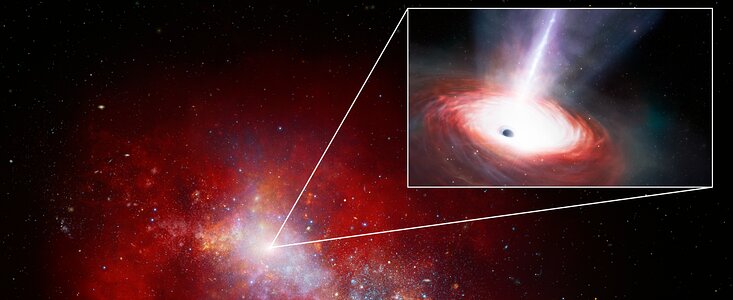NOIRLab Nuggets
Fastest Feeding Black Hole
2 December 2024
Black holes are some of the most intriguing objects in the Universe and are fascinating to astronomers, the public, and students alike. Recently, International Gemini Observatory/NSF NOIRLab astronomer Hyewon Suh led a team that discovered a black hole that is consuming matter much faster than any other black hole ever observed.
A black hole is a region of space that contains incredible amounts of matter in a very small volume to the point where gravity is so strong that not even light can escape. Although the force of gravity from a black hole is extremely strong, there is a limit on how fast it can pull in material — the Eddington limit. As material falls into a black hole, the material forms a very hot disk called an accretion disk. The hot material in the accretion disk exerts an outward pressure on the infalling material. As more material falls onto the accretion disk it heats up more. Eventually, the outward pressure from the accretion disk balances the force of gravity and limits how fast material can fall into a black hole. This limit has led to a puzzle for astronomers: How do large black holes form early in the history of the Universe?
The black hole discovered by Suh and her team, called LID-568, may help astronomers answer this question. LID-568 was initially seen in the Chandra X-Ray Observatory’s COSMOS Legacy Survey. LID-568 was conspicuous for its intense X-ray emission, but it couldn’t be seen in visible or near-infrared light. Suh’s team observed LID-568 with the James Webb Space Telescope, which can see farther into the infrared. The team found powerful outflows of gas around the black hole that led to the surprising conclusion that it was feeding at 40 times the Eddington limit!
“This black hole is having a feast,” says International Gemini Observatory/NSF NOIRLab astronomer and co-author Julia Scharwächter. “This extreme case shows that a fast-feeding mechanism above the Eddington limit is one of the possible explanations for why we see these very heavy black holes so early in the Universe.”
It’s possible the outflow observed in LID-568 may be carrying away excess energy, allowing the black hole to consume matter faster than the Eddington limit. The team is planning follow-up observations with the James Webb Space Telescope to better understand LID-568.
You can read the NOIRLab Press Release here and the original paper in Nature.
Check out NOIRLab’s Black Hole Teen Astronomy Café – To Go! for an educational activity that introduces different kinds of black holes, and applies research tools to discover their telltale signatures in astronomical observations.
Contacts
Rob Sparks
Senior Education & Engagement Specialist
NSF NOIRLab
Email: robert.sparks@noirlab.edu


